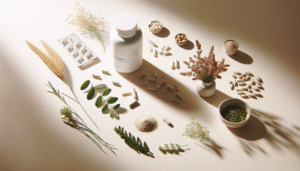Vitamin D and bone health in women over 40 are deeply connected. Often called the “sunshine vitamin,” Vitamin D is vital for maintaining strong bones, preventing osteoporosis, and supporting overall vitality.
Introduction
Vitamin D and bone health in women over 40 deserve special attention. By midlife, natural shifts in hormones, particularly declining estrogen during perimenopause and menopause, make bone density a growing concern. Bone loss accelerates in these years, increasing the risk of fractures and osteoporosis. Vitamin D, often in combination with calcium, is one of the most important nutrients to protect bone strength.
Despite this, research shows that many women over 40 are deficient. This article explores the role of Vitamin D in women’s bone health, how much you need, and practical strategies for maintaining strong bones for decades to come.
Why Vitamin D Matters After 40
Vitamin D enables the body to absorb calcium effectively and supports the continuous remodeling process that maintains bone density. Without adequate Vitamin D, even a calcium-rich diet cannot protect against fractures.
Women over 40 face accelerated bone loss, and this process speeds up after menopause. Low Vitamin D levels contribute to brittle bones, higher fracture risks, and even reduced muscle function, which further increases fall risk.
Deficiency is More Common Than You Think
Studies reveal widespread Vitamin D deficiency globally, with women in midlife being particularly vulnerable. Factors such as limited sun exposure, darker skin tones, living at higher latitudes, indoor work, and consistent sunscreen use all reduce natural Vitamin D production. Dietary intake alone rarely meets requirements, since foods like fatty fish, fortified dairy, and eggs contain relatively small amounts.
How Much Vitamin D Do Women Over 40 Need?
Most guidelines recommend 600 to 800 IU daily for women over 40, though many experts argue this may be insufficient. Blood levels of 25-hydroxyvitamin D should ideally remain above 30 ng/mL to ensure bone protection.
Because individual absorption and lifestyle vary, blood testing is the most accurate way to determine your Vitamin D status. Supplementing appropriately helps reduce bone loss and fracture risk, but excessive doses can cause toxicity.
Vitamin D, Calcium, and Synergy With Other Nutrients
Vitamin D works best when supported by other nutrients. Calcium is essential for building bone tissue, but without Vitamin D it cannot be absorbed effectively. Vitamin K2 directs calcium into bones instead of arteries, lowering the risk of calcification in blood vessels. Magnesium is also key for activating Vitamin D into its usable form.
A comprehensive supplement combining Vitamin D3, calcium, magnesium, and K2 provides a more holistic approach than Vitamin D alone.
Practical Strategies to Improve Vitamin D Status
- Sunlight: Expose arms and legs to sunlight for 10–20 minutes a few times per week, depending on skin tone and location.
- Dietary Choices: Include salmon, sardines, fortified plant-based milks, and egg yolks.
- Supplements: Choose Vitamin D3 (cholecalciferol), which is more effective than D2. Consider pairing it with calcium, magnesium, and K2 for optimal results.
The Long-Term Impact of Optimized Vitamin D
Maintaining healthy Vitamin D levels helps reduce the risk of osteoporosis, fractures, and frailty. Women who support Vitamin D and bone health in their 40s and beyond are more likely to remain active, independent, and strong as they age. Research also suggests Vitamin D supports immune balance and mood regulation, adding another layer of benefit for women navigating midlife changes.
Frequently Asked Question
1. Can I get enough Vitamin D from sunlight alone?
While sunlight is the most natural source, it may not be enough for many women. Factors such as latitude, season, air pollution, skin tone, and sunscreen use affect Vitamin D production. Women living in northern climates or spending most of their time indoors often require supplementation to maintain healthy levels.
2. Is Vitamin D3 better than D2 for bone health?
Yes. Research consistently shows that Vitamin D3 (cholecalciferol) is more effective than Vitamin D2 (ergocalciferol) at raising and maintaining serum 25-hydroxyvitamin D levels. For women over 40, D3 supplements are usually the preferred choice to support bone density and reduce fracture risk.
3. Should Vitamin D always be taken with calcium?
Vitamin D improves calcium absorption, but calcium intake should also be adequate for bone protection. If your diet lacks calcium-rich foods, pairing a Vitamin D supplement with calcium may be beneficial. Ideally, supplements should also include magnesium and Vitamin K2 for complete bone health support.
4. What are the early signs of Vitamin D deficiency?
Common symptoms include fatigue, low mood, frequent colds or infections, bone or joint pain, and muscle weakness. Long-term deficiency increases the risk of osteoporosis and fractures. Because these symptoms overlap with other conditions, blood testing is the best way to confirm deficiency.
5. Can Vitamin D supplementation be harmful?
Yes, excessive intake can cause Vitamin D toxicity, though this is rare. Symptoms include nausea, kidney problems, confusion, and dangerously high calcium levels. Most toxicity cases result from very high supplement doses over extended periods. Always check with your healthcare provider before starting high-dose Vitamin D.
6. How does menopause affect Vitamin D needs?
Menopause accelerates bone loss due to declining estrogen levels, which makes Vitamin D even more critical. Women in postmenopause are at higher risk of osteoporosis and should be proactive in maintaining sufficient Vitamin D levels through lifestyle and supplements.
7. What foods provide natural Vitamin D?
Fatty fish like salmon, mackerel, and sardines are the richest natural sources. Egg yolks and fortified foods such as dairy, orange juice, and plant-based milks also contribute. However, diet alone usually cannot meet the full requirement, especially after 40.
A Word From Vitamins For Woman
Supporting Vitamin D and bone health in women over 40 is not just about preventing osteoporosis—it’s about living with confidence and strength. The right combination of nutrients, lifestyle habits, and supplementation can help women remain active and independent throughout midlife and beyond. Take this as a reminder to check your Vitamin D status and take action. You deserve strong bones and a vibrant life at every age.
References
- Holick MF. Vitamin D deficiency. N Engl J Med. 2007;357(3):266-281.
- Lips P, Cashman KD, Lamberg-Allardt C, et al. Current vitamin D status in European and Middle East countries and strategies to prevent deficiency: a position statement. Eur J Clin Nutr. 2019;73(1):1-14.
- Weaver CM, Gordon CM, Janz KF, et al. The National Osteoporosis Foundation’s position statement on peak bone mass development and lifestyle factors. Osteoporos Int. 2016;27(4):1281-1386.
- Cashman KD, Dowling KG, Škrabáková Z, et al. Vitamin D deficiency in Europe: pandemic? Am J Clin Nutr. 2016;103(4):1033-1044.
- Bolland MJ, Grey A, Gamble GD, Reid IR. Vitamin D supplementation and musculoskeletal health: a systematic review, meta-analysis, and trial sequential analysis. Lancet Diabetes Endocrinol. 2014;2(4):307-320.







